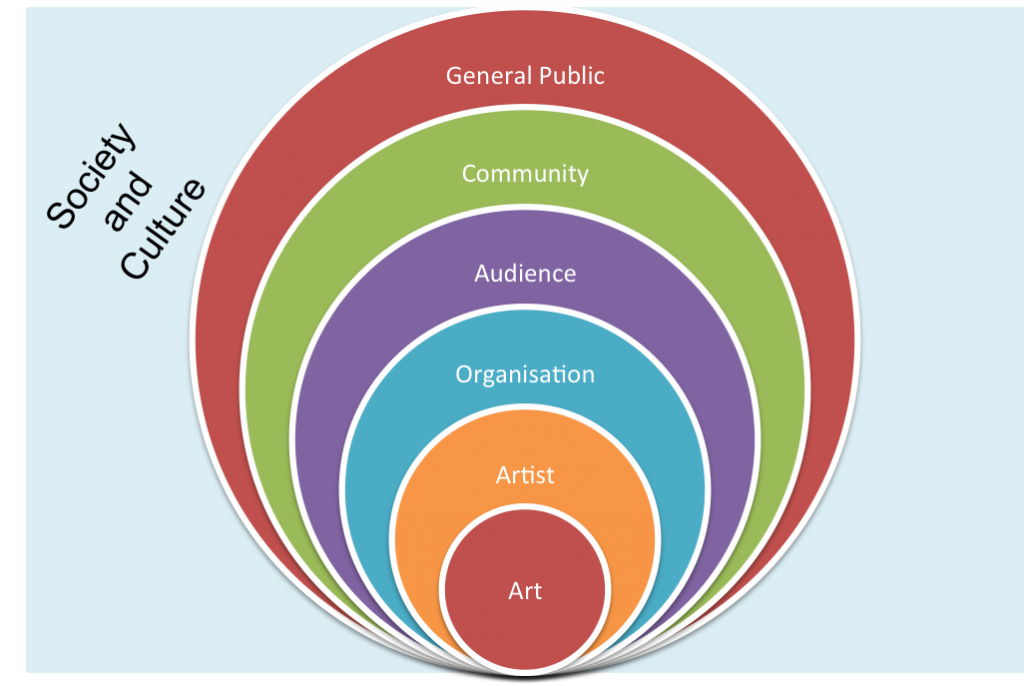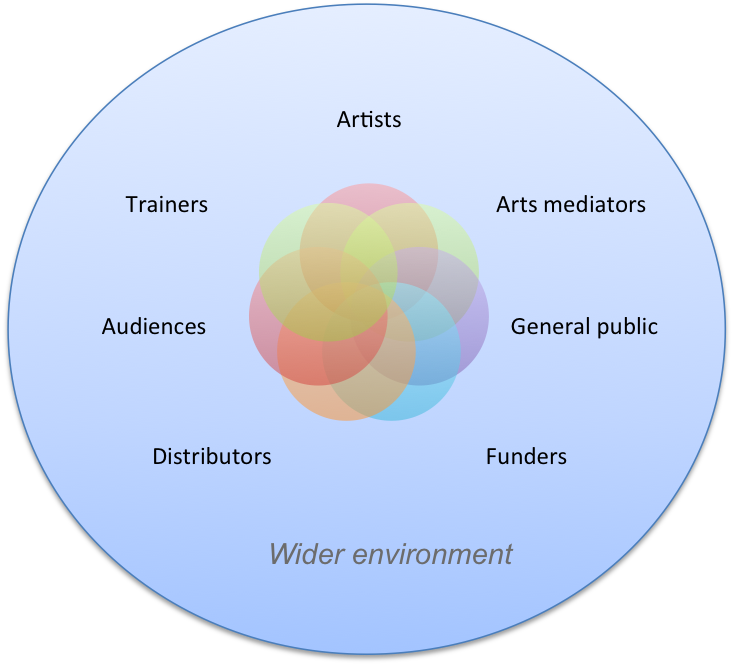I was just reading some of Dr Ann Markusen's work (Dr Markusen is the Director of the Arts Economy Initiative at the University of Minnesota), as you do. A few things cropped up which I wanted to flag here as interesting which I would love to hear others' thoughts about.
Arts and cultural ecology
In her recent work on the Californian creative economy, Markusen uses the same terminology that arts policy types in Australia have also been using for the last few years - 'ecology' rather than 'economy.' Since at least 2009 (and probably before), people working in arts policy and strategy in Australia have called the arts an 'ecology' or 'ecosystem', as a way to try to capture the the nature of the arts as a system of fluctuating relationships, and the primacy of authentic connection - between artists, organisations, audiences - the list goes on.

This is kind of like my Artistic Vibrancy Onion, so named because I think of the arts as a web of relationships across different layers of society and culture (perhaps Artistic Vibrancy Spiderweb might be more apposite?)
Here is how I tried to conceptualise the arts ecosystem for the Australia Council for the Arts when they asked me to, last year.

I drew it like this because a) I am a pretty crap drawer and b) it seemed a better way to describe the slightly miasmic soup in which artists operate, as opposed to the more traditional supply or value chain diagram of arts production.
The ecology concept allows us to think of arts happening in non-linear ways - as innovation does too. Arts happens in relationships and conversations, as does most human interaction and the fruits of human creativity. Rather than talking about it as an economy, or an industry, the arts is this space, a field (if we are going to get Bourdieuian, and why not?) in which people commune with each other and what's going on inside and outside their heads, hearts and bodies.
Naturally artists also operate as economic actors. And some parts of the arts are industrial and could be described as an industry, which implies the making of stuff and selling it and creating economic value and employment. These terms are used interchangeably, but really depend on the political goal of the conversation. For example, we talk about creative economies when we want to make the point that arts make money and contribute to GDP. We talk about the arts industry for a similar reason - to be able to talk about it in the same breath as the car manufacturing industry, or the pharmaceutical industry.
When to talk about ecologies
And so we talk about creative and cultural ecologies and ecosystems when we want to make a different point. When I use the term arts ecology, I am trying to convey quite a lot in that one word:
- There are a myriad of inter-related factors that are prerequisites for the making of art. I make this point when advocating to funders to not get rid of one part of the ecology and expect the rest to continue to survive.
- Artists are not at their core, doing it for the money. Yes, they get paid, and they sell things. But intrinsic motivation is critical to the making of good art. Prioritising process over outcome. Journey vs destination. This is documented in the 'flow' and creativity research (Czsikmihalyi). This could apply to a number of other jobs too. I use the 'ecology' terminology to remind funders and policy makers that they cannot solely rely on industrial or economic rationalist modes of thinking when they make policies about the arts.
- Audiences are not just 'consumers,' but part of the ecosystem. In the arts, the experience of art is something that happens in a relationship between the art and the audience member. This is partly why products like the iPhone do so well - the makers of that object understood that people are not just consumers, but experiencers, and the 'product' becomes theirs - it changes and is modified by the person experiencing it. It's the same with art - art cannot exist in a vacuum - it is experienced and therefore 'created' by everyone who experiences it.
- I know this sounds a bit fluffy, but it is essential to understand that the relationship between an artist and their work, the work and the audience, the artist and the audience, is a gift relationship as well as a consumer transaction. This means that audiences open themselves up and give something of themselves, more than just the money for the show. You see this understanding spreading to other sectors, like artisan foods and wines, or handmade gift products - people understanding that people don't want to be mere consumers, - they want the things they eat and buy to be extensions of their identities, a gift to themselves or a gift of themselves to others. (OK, I might be writing my dissertation on art and writing as a gift. But you get my point!)
Jackie Bailey - Principal, BYP Group
 (This post is a continuation of my ruminations on Ann Markusen's work)
(This post is a continuation of my ruminations on Ann Markusen's work)

